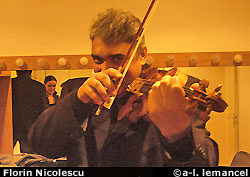Django Reinhardt symphony-style
Gypsy guitar legend revived by orchestra
Paris
19/09/2007 -

Backstage at the prestigious Théâtre des Champs-Elysées on Friday night, the corridors echoed with a joyous cacophony as violinists plied their bows, clarinettists adjusted their reeds and the brass section puffed away on their horns, tuning their instruments to the perfect pitch. Meanwhile, forming an interesting counterpoint to this background musical swell, members of the Kristiansand Symfoniorkester strode up and down the corridors, chattering excitedly away in Norwegian.
A bell eventually sounded backstage, calling a halt to the din, and the musicians filed gracefully out on stage in a seemingly interminable procession, taking their places at their music stands. Then all was silence – until a Romanian giant strode out on stage, dressed in a grey suit (which he would have preferred in black), his imposing stature enhanced by an outstretched arm brandishing a violin. The audience erupted into rapturous applause, acclaiming the arrival of Florin Nicolescu. And their enthusiastic ovation thundered on as Nicolescu was joined on stage by the Gyspy guitarist Biréli Lagrène, aka the extra-terrestrial with forty fingers.
As the musicians struck up the first notes, Django’s spirit seemed to hover in the air, gliding just beneath the Théâtre’s opulent ceiling and smiling at the extraordinary goings-on below. The guitars took flight, their impish acrobatics followed by the string section, their amazing improvisations floating above layers of romantic brass as this unique and slightly crazy project came to life before a packed house. The audience appeared to relish the fact that they were witnessing something the like of which had never been heard before: the work of Django Reinhardt, the greatest Gyspy guitarist of all time, performed by a modern symphony orchestra!
Big band influences
As the Symfoniorkester ran their virtuoso fingers over Djangology, Nuages, Place de Brouckère and Manoir de mes rêves, one of the solo guitarists was listening with a particularly attentive ear. Jon Larsen, the man behind this Utopian ideal, has "lived and breathed" Django since the 1970s, the Gypsy guitar legend becoming a veritable obsession in his life. Larsen originally started out fronting the Norwegian Hot Club, then went on to promote Gypsy music worldwide, producing Gyspy artists and witnessing a curious evolution over the years. “In the space of two decades,” he says, “I watched Django, the figurehead of French underground culture, turn into an international phenomenon!”
 |  |
The ten pieces played by the Kristiansand Symfoniorkester had been chosen with special care, selected as representing the greatest challenge for the musicians and the most interesting possibilities as far as the arrangements were concerned. “Diminishing Blackness, originally called Go Tell Mozart, was to have been Django’s first symphony,” explains Larsen, “He never learnt to write music and he must have been incredibly frustrated not to have been able to give form to what he heard in his head!”
Florin Nicolescu, a musician acclaimed as a worthy heir to Stéphane Grapelli, said that, “The structures of these pieces and the intentions behind them lent themselves 100% to orchestration. Back in the days (when Django was writing them), he was under the influence of the big bands of the 1930s and 1940s.” “Django composed as a musician and not as a guitarist,” Biréli Lagrène chimed in, “What he heard in his head went way beyond the sound of his own instrument.” Christian Escoudé, the other special guest guitarist who brought Django’s work to life that night, simply added that “Django always surprises me - he goes beyond passing fads and music fashions!”
Post-modern duel
Meanwhile, the atmosphere had visibly relaxed up on stage as Christian Escoudé joined his two guitarist friends. The conductor was swinging his hips and clicking his fingers in time to the beat and members of the orchestra frequently laid down their instruments to applaud the soloists.

At one point, Florin Nicolescu and Biréli Lagrène broke into what can only be described as a sort of post-modern “duel”, fingers flying across the frets at breakneck speed as they attempted to outdistance one another in a merciless race to the death. The battle ended with the pair bursting into laughter and dropping their weapons to embrace one another. “That’s what Americans call a challenge!” laughs Escoudé. “But it’s a healthy kind of rivalry!” he says, referring to the friendly complicity that united the three soloists throughout the performance as they frequently paused to whisper jokes in one another’s ear.
This wild, undisciplined trio eventually welcomed the two Norwegian guitarists, Jon Larsen and Andreas Oberg, into their ranks. As the drums rolled, the brass thundered and the strings wept beneath a torrent of bows, the concert built to a rousing crescendo, the musicians rising from their seats to embrace one another in a moment of pure emotion. Meanwhile, Larsen brandished his guitar high above his head, savouring his triumph and the achievement of his musical mission. That night at the Théâtre des Champs-Elysées a little bit of Django’s soul had entered everybody’s heart.
Anne-Laure Lemancel
Translation : Julie Street
22/01/2010 -
05/04/2005 -
16/05/2003 -
14/12/2001 -










